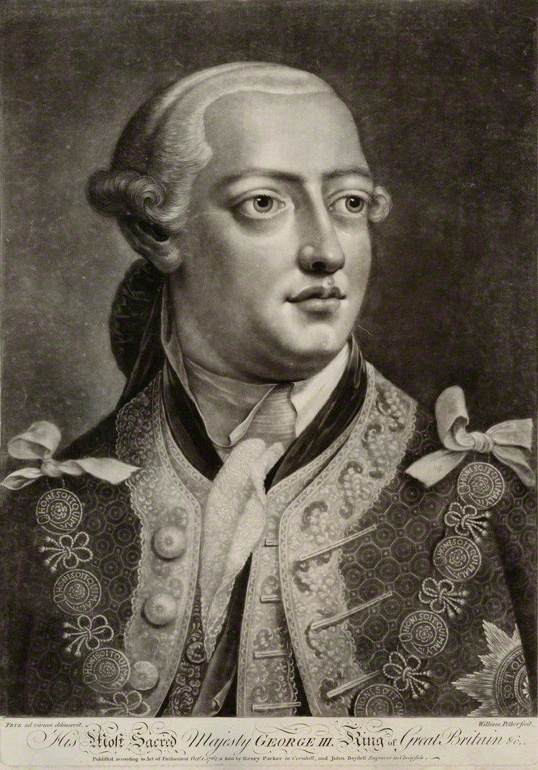William Pether on:
[Wikipedia]
[Google]
[Amazon]
William Pether (c. 1739 – 19 July 1821) was primarily an English
 In 1762 he engraved Frye's portrait of George III in three sizes, and during the following fifteen years executed engravings after English, Dutch, and Italian masters, especially
In 1762 he engraved Frye's portrait of George III in three sizes, and during the following fifteen years executed engravings after English, Dutch, and Italian masters, especially
mezzotint
Mezzotint is a monochrome printmaking process of the '' intaglio'' family. It was the first printing process that yielded half-tones without using line- or dot-based techniques like hatching, cross-hatching or stipple. Mezzotint achieves tonali ...
engraver, but also decorated porcelain, made oil paintings and pastel drawings, and invented gadgets.
Life
He was born inLondon
London is the capital and largest city of England and the United Kingdom, with a population of just under 9 million. It stands on the River Thames in south-east England at the head of a estuary down to the North Sea, and has been a majo ...
in 1739, and became a pupil of Thomas Frye
Thomas Frye (c. 1710 – 3 April 1762) was an Anglo-Irish artist, best known for his portraits in oil and pastel, including some miniatures and his early mezzotint engravings. He was also the patentee of the Bow porcelain factory, London, ...
, with whom he entered into a partnership in 1761.
Pether was a fellow of the Incorporated Society of Artists and contributed to its exhibitions' paintings, miniatures, and engravings from 1764 to 1777. He was also an occasional exhibitor with the Free Society and the Royal Academy. He had many pupils, including Henry Edridge
Henry Edridge (1768 in Paddington – 23 April 1821 in London) was the son of a tradesman and apprenticed at the age of fifteen to William Pether, a mezzotinter and landscapist, and became proficient as a painter of miniatures, portraits ...
and Edward Dayes
Edward Dayes (1763 in London – May 1804 in London) was an English watercolour painter and engraver in mezzotint.
Life
He studied under William Pether, and began to exhibit at the Royal Academy in 1786, when he showed a portrait and views o ...
. He often changed his residence from London to the provinces and back again; and gradually sank into obscurity and neglect.
At the beginning of the 19th century Pether appears to have settled at Bristol
Bristol () is a city, ceremonial county and unitary authority in England. Situated on the River Avon, it is bordered by the ceremonial counties of Gloucestershire to the north and Somerset to the south. Bristol is the most populous city in ...
, where he made a living as a drawing-master and picture-cleaner; and there he engraved portraits of Edward Colston
Edward Colston (2 November 1636 – 11 October 1721) was an English merchant, slave trader, philanthropist, and Tory Member of Parliament.
Colston followed his father in the family business becoming a sea merchant, initially trading in wine ...
the slave trader and Bristol benefactor, after Jonathan Richardson the Elder, and Samuel Syer, the historian of Bristol (1816).
Pether died in Montague Street, Bristol, on 19 July 1821, aged 82 or 83, having long been forgotten in the art world.
Works
 In 1762 he engraved Frye's portrait of George III in three sizes, and during the following fifteen years executed engravings after English, Dutch, and Italian masters, especially
In 1762 he engraved Frye's portrait of George III in three sizes, and during the following fifteen years executed engravings after English, Dutch, and Italian masters, especially Rembrandt
Rembrandt Harmenszoon van Rijn (, ; 15 July 1606 – 4 October 1669), usually simply known as Rembrandt, was a Dutch Golden Age painter, printmaker and draughtsman. An innovative and prolific master in three media, he is generally consid ...
and Joseph Wright of Derby
Joseph Wright (3 September 1734 – 29 August 1797), styled Joseph Wright of Derby, was an English landscape and portrait painter. He has been acclaimed as "the first professional painter to express the spirit of the Industrial Revolution".
Wr ...
, with strong effects of light and shade. His plates of ''The Jewish Bride'', 1763, ''Jewish Rabbi'', 1764, ''Officer of State'', 1764, and ''Lord of the Vineyard'', 1766, after Rembrandt, and ''A Lecture on the Orrery'', 1768, ''Drawing from the Gladiator'', 1769, ''The Hermit'', 1770, and ''The Alchymist'', 1775, after Wright, were noted as mezzotint work. Pether engraved altogether about fifty plates, some of which were published by John Boydell
John Boydell (; 19 January 1720 (New Style) – 12 December 1804) was a British publisher noted for his reproductions of engravings. He helped alter the trade imbalance between Britain and France in engravings and initiated a British tradition i ...
, but the majority by himself at various addresses in London.
Pether was also a miniaturist and painted some life-sized portraits in oil, three of which— Sarah Bates the singer, the brothers Smith of Chichester, and himself in Spanish dress—he also engraved. In 1777 he sent his own portrait with the disguised title, ''Don Mailliw Rehtep''.
His last plate published in London is dated 1793, and he exhibited at the Royal Academy for the last time in 1794.
References
* *Dominika Cora, 'New Light on the Life and Work of the Mezzotint Engraver William Pether (1739-1821)',Print Quarterly
''Print Quarterly'' is an international academic journal devoted to the history and art of printmaking, from its origins to the twentieth and twenty-first centuries. It is published in London four times a year, in March, June, September, and Decem ...
, vol. XXXVIII, no.3 (September 2021) pp. 289–301.
;Attribution
{{DEFAULTSORT:Pether, William
1738 births
1821 deaths
English engravers
People from Carlisle, Cumbria
Artists from Bristol